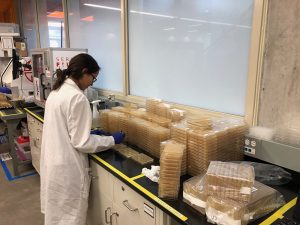A research team from Colorado State University, Virginia Tech and GenoFAB – a cloud computing company focused on high-throughput laboratory automation – have completed one of the largest quantitative experiments looking at the genetic control of cell growth and division in yeast. The high-throughput industrial-scale study, which looked at 630 interactions of 36 carefully selected cell-cycle genes (6589 mutants), was designed to build a more powerful mathematical model of cell cycle control and to establish principles for computer-aided experimental design of large-scale biological experiments. The work, which is published online in npj Systems Biology and Applications, drastically reduces the impact of poorly reproducible data arising from the study of large-scale biological systems.

Dr. Jenna Gallegos, co-first author of the publication, performing one biological repetition of the genetic screen
By focusing their attention on the inner workings of yeast, scientists have made remarkable progress in learning how cells control cell division and growth. At the same time researchers have struggled to bring together the benefits of “going narrow and digging deep” (reductionism) and the less biased approach of “casting the net wide” (systems biology). To bridge this gap, researchers have turned to mathematical modeling but have been plagued by the constraints of data scarcity, poor data quality, and lack of reproducibility.
“The main challenge of this project, which took four years of intensive effort, was to bring an industrial mindset to the experimental design, study and data analysis of essential biological traits in more than 6000 yeast cell cycle mutants,” said Jean Peccoud, Professor of Chemical and Biological Engineering at Colorado State University and founder of GenoFAB. “We deliberately chose to perform an unprecedented level of biological replicates to estimate the reproducibility of our own data and resolve discrepancies in previously published results.”
The researchers looked at synthetic lethal double mutants, a type of yeast mutant where the problems of reproducibility are particularly acute due to the inevitable errors of interpretation of very small differences in traits between some parent and daughter cells. Synthetic lethal mutations arise when viable yeast cells carrying deletions of two different genes are crossed to produce double-mutant cells that are unable to grow and survive.
Alex Hutagalung, Co-founder and Chief Scientific Officer of Levadura Biotechnology, who was not an author on the paper, remarked: “Synthetic lethality is never a straightforward phenotype and variability in large-scale screens often poses major challenges for researchers and modelers. It is essential that each interaction is always verified independently of the screen and it is impressive that this has been done with such rigor in these experiments.”
“Process automation was foremost in our minds due to the scale of the undertaking,” said Mark Rogers, Director of Bioinformatics at GenoFAB. “Insightful statistical analysis demands proper planning upfront: one needs to understand the nature of the data being measured before an experiment even starts. We designed the data analysis work-flow in advance and mapped all the steps in the process before work began. We think the process-oriented, model-driven experiments we are conducting to better understand cell division in yeast provide guiding principles that we can use to help other researchers adopt a high-throughput approach to other discovery and product development projects.”
Gallegos, J.E., Adames, N.R., Rogers, M.F. et al. Genetic interactions derived from high-throughput phenotyping of 6589 yeast cell cycle mutants. npj Syst Biol Appl 6, 11 (2020).





